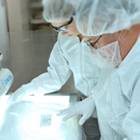BIOSENSIS PTY
Artikel-Nr:
(BSENS-080-100)
Lieferant:
Biosensis
Hersteller-Artikelnummer::
S-080-100
Lokale Artikelnummer::
BSENS-080-100
Beschreibung:
Nerve growth factor (NGF) is synthesized as a precursor (proNGF) which may be released and have physiological functions to cause cell death. It binds neurotrophin receptor p75 and sortilin and may also be important for the development of nervous system. proNGF is synthesized in target tissues and glia, transported retrogradely and may be released. This antibody is raised in sheep to detect the prodomain of NGF not the mature peptide.
VE:
1 * 100 µl
Artikel-Nr:
(BSENM-026-50-AT)
Lieferant:
Biosensis
Hersteller-Artikelnummer::
M-026-50-AT
Lokale Artikelnummer::
BSENM-026-50-AT
Beschreibung:
Monoclonal antibody MC192 against the rat low affinity nerve growth factor receptor (p75NTR) is derived from the fusion of Sp2/0-Ag 14 myeloma cells with mouse immune splenocytes. MC192 monoclonal antibody was originally generated by Chandlers et al. p75NTR was originally discovered as a low affinity nerve growth factor receptor. Later it was found that it was the receptor for all neurotrophins. It mediates signals of neurotrophins for neuronal survival, apoptosis, neurite outgrowth and synaptic plasticity. Recently, it has been revealed that p75NTR not only acts as the receptor for neurotrophins but also the receptor for many other pathological ligands such as prions, rabies virus and amyloid beta. p75NTR also acts as a co-receptor for NOGO which mediates inhibitory signals of myelin associated protein. p75NTR is highly expressed in a number of non-neuronal and neuronal cells including motor neurons during development and also in damaged neurons. MC192 has a potential use as the ligand for gene delivery into p75NTR-expressing rat cells via a receptor-mediated mechanism.
This antibody reacts with rat only. Does not react with mouse or human NGFR
VE:
1 * 50 µG
Artikel-Nr:
(BSENR-1592-100)
Lieferant:
Biosensis
Hersteller-Artikelnummer::
R-1592-100
Lokale Artikelnummer::
BSENR-1592-100
Beschreibung:
Peroxiredoxin-3 has a role in redox regulation of the cell.
VE:
1 * 100 µG
Artikel-Nr:
(BSENR-053-100)
Lieferant:
Biosensis
Hersteller-Artikelnummer::
R-053-100
Lokale Artikelnummer::
BSENR-053-100
Beschreibung:
TISSUE SPECIFICITY: Predominantly expressed in trigeminal and dorsal root sensory ganglia. Isoform 1 and isoform 3 are also expressed in brain and peripheral blood mononuclear cells.
VE:
1 * 100 µl
Artikel-Nr:
(BSENR-151-100)
Lieferant:
Biosensis
Hersteller-Artikelnummer::
R-151-100
Lokale Artikelnummer::
BSENR-151-100
Beschreibung:
TrkC is a member of the neurotrophic tyrosine receptor kinase family. TrkC is a membrane-bound receptor that upon neurotrophin binding, phosphorylates itself and members of the MAPK pathway. TrkC is the receptor for neurotrophin-3 (NT-3). Signalling through TrkC leads to cell differentiation and may play a role in the development of proprioceptive neurons that sense body position. SUBUNIT: Exists in a dynamic equilibrium between monomeric (low affinity) and dimeric (high affinity) structures. SUBCELLULAR LOCATION: Membrane; single-pass type I membrane protein. ALTERNATIVE PRODUCTS: 4 named isoforms produced by alternative splicing. Additional isoforms seem to exist. Mutations in TrkC have been associated with medulloblastomas, secretory breast carcinomas and other cancers.
VE:
1 * 100 µl
Artikel-Nr:
(BSENC-1812-50)
Lieferant:
Biosensis
Hersteller-Artikelnummer::
C-1812-50
Lokale Artikelnummer::
BSENC-1812-50
Beschreibung:
Required for brain and eye development. Promotes the disassembly of phosphorylated vimentin intermediate filaments (IF) during mitosis and may play a role in the trafficking and distribution of IF proteins and other cellular factors to daughter cells during progenitor cell division. Required for survival, renewal and mitogen-stimulated proliferation of neural progenitor cells (By similarity). Ref: uniprot.org
VE:
1 * 50 µl
Artikel-Nr:
(BSENS-1754-500)
Lieferant:
Biosensis
Hersteller-Artikelnummer::
S-1754-500
Lokale Artikelnummer::
BSENS-1754-500
Beschreibung:
Sheep serum from non-immunised animals was purified by protein G affinity chromatography. This sheep IgG fraction can be used as negative control antibody for various immunological techniques where sheep primary antibodies are used.
VE:
1 * 500 µG
Artikel-Nr:
(BSENR-1621-100)
Lieferant:
Biosensis
Hersteller-Artikelnummer::
R-1621-100
Lokale Artikelnummer::
BSENR-1621-100
Beschreibung:
This gene encodes an enzyme which catalyzes the biosynthesis of the neurotransmitter acetylcholine. This gene product is a characteristic feature of cholinergic neurons, and changes in these neurons may explain some of the symptoms of Alzheimer's disease. Polymorphisms in this gene have been associated with Alzheimer's disease and mild cognitive impairment. Mutations in this gene are associated with congenital myasthenic syndrome associated with episodic apnea. Multiple transcript variants encoding different isoforms have been found for this gene, and some of these variants have been shown to encode more than one isoform. [provided by RefSeq, May 2010]
VE:
1 * 100 µG
Artikel-Nr:
(BSENR-1694-100)
Lieferant:
Biosensis
Hersteller-Artikelnummer::
R-1694-100
Lokale Artikelnummer::
BSENR-1694-100
Beschreibung:
The spectrin family of proteins were originally discovered as major components of the submembraneous cytoskeleton of osmotically lysed red blood cells (1). The lysed blood cells could be seen as clear red blood cell shaped objects in the light microscope and were referred to as red cell "ghosts". The major proteins of these ghosts proved to be actin, ankyrin, band 4.1 and several other proteins, including two major bands running at about 240kDa and 260kDa on SDS-PAGE gels. This pair of bands was named "spectrin" since they were discovered in these red blood cell ghosts (1). Later work showed that similar high molecular bands were seen in membrane preparations from other eukaryotic cell types. Work by Levine and Willard described a pair of about ~240-260kDa molecular weight bands which were transported at the slowest rate along mammalian axons (2). They named these proteins "fodrin" as antibody studies showed that they were localized in the sheath under the axonal membrane, but not in the core of the axon (2; fodros is Greek for sheath). Subsequently fodrin was found to be a member of the spectrin family of proteins, and the spectrin nomenclature is now normally used (3). Spectrins form tetramers of two alpha and two beta subunits, with the alpha corresponding to the lower molecular weight ~240kDa band and the beta corresponding to the ~260kDa or in some case much larger band. Most spectrin tetramers are about 0.2microns or 200nm long, and each alpha and beta subunit has a cell type specific expression pattern. The basic structure of each spectrin subunit is the spectrin repeat, which is a sequence of about 110 amino acids which defines a compact domain contain three closely packed alpha-helices. Each spectrin subunit contains multiple copies of this repeat, with 20 in each of the alpha subunits. The beta I-IV subunits each contain 17 spectrin repeats, while the beta V subunit, also known as beta-heavy spectrin, contains 30 of these repeats. The various subunits also contain several other kinds of functional domain, allowing the spectrin tetramer to interact with a variety of protein, ionic and lipid targets. The alpha-subunits each contain one calmodulin like calcium binding region and one Src-homology 3 (SH3) domain, an abundant domain involved in specific protein-protein interactions. The beta subunits all have a N-terminal actin binding domain and may also have one SH3 domain and one pleckstrin homology domain, a multifunctional type of binding domain which in beta I spectrin at least binds the membrane lipid PIP2 (5). Spectrins are believed to have a function in giving mechanical strength to the plasma membrane since the tetramers associate with each other to form a dense submembraneous geodesic meshwork (3). They also bind a variety of other membrane proteins and membrane lipids, and the proteins they bind to are therefore themselves localized in the membrane. Diseases may be associated with defects in one or other of the spectrin subunits (6). For example, some forms of hereditary spherocytosis, the presence of spherical red blood cells which are prone to lysis, can be traced to mutations in some of the spectrin subunits (7). The alpha-II subunit is widely expressed in tissues but, in the nervous system, is found predominantly in neurons. The antibody can therefore be used to identify neurons and fragments derived from neuronal membranes in cells in tissue culture and in sectioned material.
VE:
1 * 100 µl
Artikel-Nr:
(BSENR-080-100)
Lieferant:
Biosensis
Hersteller-Artikelnummer::
R-080-100
Lokale Artikelnummer::
BSENR-080-100
Beschreibung:
GDNF is a glycosylated, disulfide-bonded homodimer molecule. It was first discovered as a potent survival factor for midbrain dopaminergic neurons and was then shown to rescue these neurons in animal models of Parkinson's disease. GDNF is about 100 times more efficient survival factor for spinal motor neurons than the neurotrophins. FUNCTION: Neurotrophic factor that enhances survival and morphological differentiation of dopaminergic neurons and increases their high-affinity dopamine uptake. SUBUNIT: Homodimer; disulfide-linked. SUBCELLULAR LOCATION: Secreted protein. ALTERNATIVE PRODUCTS: 2 named isoforms produced by alternative splicing. DISEASE: Defects in GDNF may be a cause of Hirschsprung disease (HSCR). In association with mutations of RET gene, defects in GDNF may be involved in Hirschsprung disease. This genetic disorder of neural crest development is characterized by the absence of intramural ganglion cells in the hindgut, often resulting in intestinal obstruction. DISEASE: Defects in GDNF are a cause of congenital central hypoventilation syndrome (CCHS); also known as congenital failure of autonomic control or Ondine curse. CCHS is a rare disorder characterized by abnormal control of respiration in the absence of neuromuscular or lung disease, or an identifiable brain stem lesion. A deficiency in autonomic control of respiration results in inadequate or negligible ventilatory and arousal responses to hypercapnia and hypoxemia. SIMILARITY: Belongs to the TGF-beta family. GDNF subfamily.
VE:
1 * 100 µl
Artikel-Nr:
(BSENR-1590-100)
Lieferant:
Biosensis
Hersteller-Artikelnummer::
R-1590-100
Lokale Artikelnummer::
BSENR-1590-100
Beschreibung:
Peroxiredoxin-1 has a role in redox regulation of the cell.
VE:
1 * 100 µG
Artikel-Nr:
(BSENR-1313-100)
Lieferant:
Biosensis
Hersteller-Artikelnummer::
R-1313-100
Lokale Artikelnummer::
BSENR-1313-100
Beschreibung:
Maltose binding protein (MBP) is encoded by the malE gene of E.coli. MBP is often used in protein expression studies because it creates a stable fusion product that does not appear to interfere with the bioactivity of the protein of interest. It also allows for its easy purification from bacterial extracts under mild conditions.
VE:
1 * 100 µG
Artikel-Nr:
(BSENR-160-100)
Lieferant:
Biosensis
Hersteller-Artikelnummer::
R-160-100
Lokale Artikelnummer::
BSENR-160-100
Beschreibung:
FUNCTION: Plays a role in autophagy. SUBCELLULAR LOCATION: Membrane; multi-pass membrane protein (Potential). ALTERNATIVE PRODUCTS: 3 named isoforms produced by alternative splicing. SIMILARITY: Belongs to the ATG9 family. IN YEAST: FUNCTION: Involved in autophagy and cytoplasm to vacuole transport (Cvt) vesicle formation. Recruites ATG23 and ATG8 to the pre-autophagosomal structure. SUBUNIT: Interacts with ATG18, ATG2 and ATG23. SUBCELLULAR LOCATION: Membrane; multi-pass membrane protein. Preautophagosomal structure; preautophagosomal structure membrane; multi-pass membrane protein. Note=Pre-autophagosomal and other perivacuolar punctate structures. The proper trafficking of ATG9 between the pre-autophagosomal structure and the other punctate structures requires ATG2, ATG18, ATG23, the ATG1-ATG13 complex and the phosphatidylinositol 3-kinase complex I. SIMILARITY: Belongs to the ATG9 family.
VE:
1 * 100 µl
Artikel-Nr:
(BSENR-168-100)
Lieferant:
Biosensis
Hersteller-Artikelnummer::
R-168-100
Lokale Artikelnummer::
BSENR-168-100
Beschreibung:
SOD1 binds copper and zinc ions ans is one of two isozymes responsible for destroying free superoxide radicals which are normally produced within the cells and which are toxic to biological systems. SOD1 is a soluble cytoplasmic protein, acting as a homodimer to convert superoxide radicals to molecular oxygen and hydrogen peroxide. Defects in SOD1 are the cause of amyotrophic lateral sclerosis type 1 (ALS1) which is a neurodegenerative disorder affecting upper and lower motor neurons and resulting in fatal paralysis.
VE:
1 * 100 µl
Artikel-Nr:
(BSENM-1314-100)
Lieferant:
Biosensis
Hersteller-Artikelnummer::
M-1314-100
Lokale Artikelnummer::
BSENM-1314-100
Beschreibung:
The Myc tag contains the amino acids Glu-Gln-Lys-Leu-Ile-Ser-Glu-Glu-Asp-Leu (E-Q-K-L-I-S-E-E-D-L) corresponding to amino acids 410-419 of human Myc. This tag is widely used for monitoring expression of recombinant proteins in bacteria, insect and mammalian cells.
VE:
1 * 100 µG
Artikel-Nr:
(BSENR-1547-100)
Lieferant:
Biosensis
Hersteller-Artikelnummer::
R-1547-100
Lokale Artikelnummer::
BSENR-1547-100
Beschreibung:
Lysine acetylation of histones and non-histone proteins plays an important part in many cellular processes such as chromatin and nuclear signaling, transcription, gene silencing, cell cycle progression, apoptosis, differentiation, DNA replication and repair.
VE:
1 * 100 µl
Preis auf Anfrage
Lager für diesen Artikel ist begrenzt, kann aber in einem Lagerhaus in Ihrer Nähe zur Verfügung. Bitte stellen Sie sicher, dass Sie in sind angemeldet auf dieser Seite, so dass verfügbare Bestand angezeigt werden können. Wenn das
Lager für diesen Artikel ist begrenzt, kann aber in einem Lagerhaus in Ihrer Nähe zur Verfügung. Bitte stellen Sie sicher, dass Sie in sind angemeldet auf dieser Seite, so dass verfügbare Bestand angezeigt werden können. Wenn das
Dieses Produkt kann nur an eine Lieferadresse versandt werden die über die entsprechende Lizenzen verfügt. Für weitere Hilfe bitte kontaktieren Sie Ihr VWR Vertriebszentrum.
-Additional Documentation May be needed to purchase this item. A VWR representative will contact you if needed.
Dieses Produkt wurde von Ihrer Organisation gesperrt. Bitte kontaktieren Sie Ihren Einkauf für weitere Informationen.
Dieses Produkt ist Ersatz für den von Ihnen gewünschten Artikel.
Dieses Produkt ist nicht mehr verfügbar. Bitte kontaktieren Sie den VWR Kundenservice.
|
|||||||||

















































